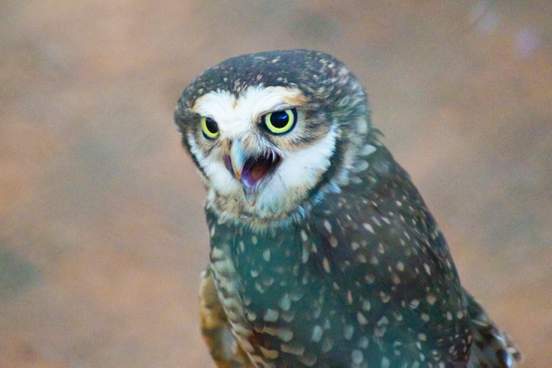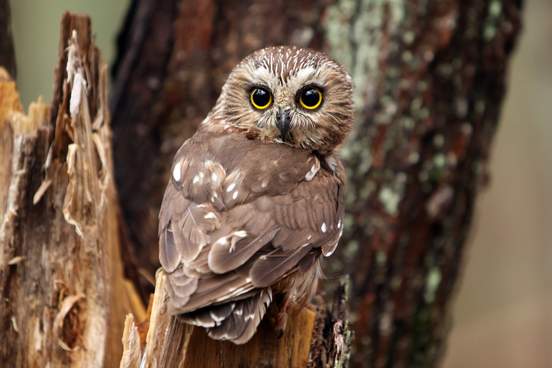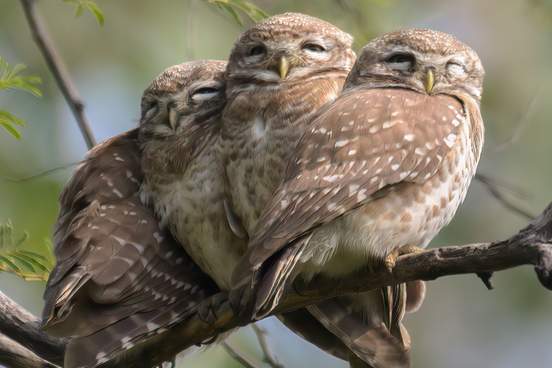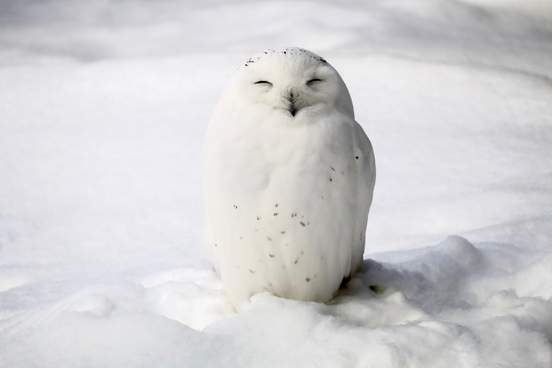
Owl
Definition: any of an order (Strigiformes) of chiefly nocturnal birds of prey with a large head and eyes, short hooked bill, strong talons, and soft fluffy often brown-mottled plumage
Some people like Super Bowls, others prefer Superb Owls, and some enjoy both! We're not here to judge. Whether you're avoiding the big game, or just taking a break during halftime, if you give a hoot about owls, we’ve got some fun words to know, and stories about them as well.
We begin with owl, English’s go-to word for our fine feathered friends of the order Strigiformes for centuries, dating back to the Old English ūle, which shares an ancestor with the Old High German word for “owl,” uwila. There are many species of owl, and each of these has accumulated a variety of names in English over the years. Some are named for their appearance, such as the spotted owl and great horned owl; some for places where they live, like the burrowing owl and barn owl; and some for their sweet sweet vocal style, such as those of the screech owl and saw-whet owl. Of course, most of us can’t tell a gillhooter from a bitter-bump, as the old Lancashire saying goes (see the slide for gillhooter below), so plain ole owl is perfectly fine as well. They won’t mind.
On warm summer nights, barred owls boomed their eerie calls and cackles back and forth across the creek bottom as the numbing chants of whip-poor-wills and choruses of katydids and crickets lulled me to sleep.
— J. Drew Lanham, The Home Place: Memoirs of a Colored Man’s Love Affair with Nature (2017)As I listen to the owls speaking to each other, moving through the forest, engaging in a slow dance over the next three hours that takes them in a great circle around the pond, up slope and down, from the birches to the pines on the high slope, I remember one of our stories. It tells how Great Horned Owl fell in love with a young Penobscot woman who said she would marry only the greatest hunter. He disguised himself as a human, placing a hood over his head.
— Joseph Bruchac, “At the Edge of Ridge Road” (2000)It was a hot evening, and all the night creatures were excited by the heat. The crickets, katydids, mosquitos, frogs, and night birds were too loud, something was shaking a nearby bush, and an owl screamed from the treetops.
— Nnedi Okorafor, Akata Woman (2022)I didn’t have to guess too long about what species I’d spotted, though: I’d taken photos. My grainy shots eventually made their way to an ornithologist in Vladivostok named Sergey Surmach, the only person working with fish owls in the region. It turned out that no scientist had seen a Blakiston’s fish owl so far south in a hundred years, and my photographs were evidence that this rare, reclusive species still persisted.
— Jonathan C. Slaght, Owls of the Eastern Ice: A Quest to Find and Save the World’s Largest Owl (2020)

Billywix
Definition: a tawny owl (Strix aluco); broadly: an owl
Our unabridged dictionary records many common names for owls from various English dialects, and you must forgive our momentary suspension of editorial neutrality when we say that many of them are simply delightful. Case in point: billywix (also styled Billy-wix, Billy Wix, etc.), which according to some sources arose in the region of East Anglia. Etymologists today aren’t certain of the origins of billywix, though in 1870 one Ebenezer Cobham Brewer suggested in his Dictionary of Phrase and Fable (in which he defined Billy Wix as referring to any owl, not specifically the tawny owl) that “Billy is a play upon the beak or bill, which is very striking in the owl, and Wix is the german weck (a wig), alluding to the ‘judge-like’ appearance of Master Madge.”
It is curious to observe the number of Christian names, both male and female, which are specifically appropriated to particular birds. … If we extend the list of local ornithological nomenclature, we may add that, in Shropshire, according to Hartshorne, the swift is called Jack-squealer; the blackcap, Jack-straw; the willow wren, Ground Isaac; in Suffolk (as given by Moor), the goldfinch, King Harry; the curlew, Jack-curlew; in Gloucestershire, the hedge-sparrow obtains the name of Blue Isaac; in Cheshire the wagtail is called Billy-biter; and in East Anglia, an owl is called Billy-wix.
— Anne Elizabeth Baker, Glossary of Northamptonshire words and phrases (1854)

Madge
Definition: a barn owl; broadly: an owl
Background:
If “Master Madge” in the slide above had you scratching your head, know that madge, likely short for “Margaret,” is another word that has been used for owls generally, and the barn owl in particular. Variants of madge include madge owl, gillhooter, gillihowlet, madge howlet, hissing owl, screech owl, white owl, church owl, padge, and padge owl. If that’s not enough, some Brits also use madge to refer to the magpie. Who-who-who’s confused?
‘I would rather drink and be merry,’ said Friar John. But Panurge remained deep in contemplation of the popinjay and his company, till suddenly he saw a madge-owl beneath the cage and cried out: ‘My God, we’re all caught in a trap. Here’s quick-trickery, and slick lock-pickery in this place. Look at that stuffed madge-owl. We’re decoyed and done for, I swear we are.’
— François Rabelais (trans. J. M. Cohen), The Histories of Gargantua and Pantagruel (Penguin, 1955)

Tu-whit tu-whoo
Definition: the cry of an owl
You may, when reading the definition of tu-whit tu-whoo, think “Gee, that doesn’t sound like the owl(s) I know!” That’s because the writers who jotted it down—Shakespeare among them—could only, understandably, consider the species most familiar to them. The Oxford English Dictionary explains that tu-whit often represents “the short shrill contact call of the female tawny owl, to which the male responds with a hooting sound,” with the hooting sound being tu-whoo. In the quote below from Bird Life and Bird Lore, note that “brown owl” is another common name for the tawny owl. Especially since many birds—including owls—are more often heard than seen, you may be interested in this article about bird calls and the words used to describe them.
When the brown owl hoots, her neck swells out, as old Gilbert White remarked, to the size of a hen’s egg; and it is worth noting that, while most of the poets and almost all ordinary listeners regard her hoot as melancholy, and nothing but melancholy … yet there is a minority among the poets which, on occasion, take the other view; and it is a minority which deserves to be heard; Shakespeare, Sir Walter Scott, and T. Nash among the number. What says Shakespeare?—
“… Then nightly sings the staring, owl,
Tu-whoo!
Tu-whit! Tu-whoo! a merry note!”
— R. Bosworth Smith, Bird Life and Bird Lore (1906)

Saw-whet
Definition: a very small harsh-voiced North American owl (Aegolius acadicus) that is largely dark brown above and chestnut streaked with white beneath
Speaking of owl calls, the piping, tooting call of the saw-whet, or northern saw-whet owl, reminded at least one very convincing person in the early 1800s of the sound of a saw being filed, so here we are. Both saw and whet have ancient lineages in English, dating back to the Old English words sagu and hwettan, respectively.
When she turned to look into the catbrier thicket, a wide-eyed saw-whet blinked back.
— Patricia and Clay Sutton, How to Spot an Owl (1994)

Howlet
Definition: an owl or owlet
There is some disagreement about the origins of howlet (rest assured that etymological disagreements are usually quite mild). Some sources record that the word comes from the Middle English howlat or howlott, which in turn combined an Old English word for “owl” with the suffix -et to signify “small one.” Others suggest that howlet is a direct borrowing of the French hulotte. Regardless, despite the character of Hubert’s assertions to the contrary in Mabel Dearmer’s 1906 novel Brownjohn’s, the inclusion of howlet in Robert Browning’s work was certainly not the result of a printer’s error. Enough with the howlet-splaining, Hubert!
‘Do you mean that this is a “stubbed ground,” and full of thistles and docks and bats and howlets?’ she asked.
… He paused. ‘You shouldn’t say “howlets”; you should say “owlets,”’ he added, after a moment’s thought.
‘Well!’ exclaimed Barbara indignantly, drawing her scissors back from a rose-stalk. ‘I like that! It says “howlets” in the book.’ ‘Printer’s error! Browning meant ‘owlets,’—little owls, don’t you know?’
— Mabel Dearmer, Brownjohn’s (1906)Will the night send a howlet or a bat?
— Robert Browning, “Childe Roland to the Dark Tower Came”

Harfang
Definition: a snowy owl : a large ground-nesting diurnal arctic owl (Nyctea scandiaca) that enters the chiefly northern parts of the U.S. in winter and has plumage that is sometimes nearly pure white but usually with brownish spots or bars
Harfang entered English a lot more recently than some of the other words on this list, in the late 18th century. It comes from the Swedish word harfång, literally, “hare catcher,” in turn from hare (from Old Swedish hari) + fånga, “to catch.” Fans of C. S. Lewis may remember Harfang from The Silver Chair, one of the installments in his series The Chronicles of Narnia, as the name of the northern castle of “Gentle Giants.”
The Arctic regions, then, may be regarded as the present home of the Harfang; but it sometimes appears outside those limits, though in an irregular manner.
— Edouard Lartet and Henry Christy, Reliquiae Aquitanicae; being contributions to the Archaeology and Palaeontology of Périgord and the Adjoining Provinces of Southern France (1875)

Gillhooter
Definition: a barn owl; broadly: an owl
The hooter in gillhooter is pretty self-explanatory in reference to an owl, but whence gill? The gill, it turns out, is short for the name Gillian, and means “girl” or “sweetheart.” Gillhooter may be, and has been, used for male or female (usually barn) owl, however, as can jenny howlet.
Thoose ‘ut couno’ tell a bitter-bump fro’ a gillhooter [a bittern from an owl].
— John Harland and T. T. Wilkinson, Lancashire Legends, Traditions, Pageants, Sports, &c. with an appendix containing A Rare Tract on the Lancashire Witches (1873)

Strix
Definition: the type genus of the family Strigidae comprising owls that lack ear tufts and including the tawny owl and the barred owl
With so many different common names for owls flying around, things can get real confusing real fast. Thankfully, the scientific naming system of plants, animals, etc. known as binomial nomenclature is there to help people—especially scientists—stay on the same page with respect to what bird they’re talking about. Bionomial nomenclature assigns every species a name of two terms, of which the first identifies the genus to which it belongs and the second the species itself. Strix aluco, for example, is the scientific name for the owl known alternately as billywix, brown owl, or tawny owl, among other sobriquets.
Problem solved, right? Not so fast! Taxonomists are wont to reclassify and reorder plants and animals as new information comes to light. The genus Strix, for example at one time contained most owls except barn owls, and at another was comprised solely of barn owls. Today it comprises owls that lack ear tufts, including our friend billywix and its North American cousin the barred owl (whose call, often transcribed as “who-cooks-for-you, who-cooks-for-you-all” inspired this article’s subtitle). If that weren’t enough, Strix comes from the Latin word for “screech owl.” No, not either of the two North American screech owls but ole Madge herself, the barn owl (also sometimes called a screech owl in common parlance because that bird can screech), which is no longer included in the genus Strix but rather Tyto. Whew!
One of the best ways to encounter an owl in winter is to try for one of our common nocturnal owls on an “owling” excursion. Great horned owls (Bubo virginianus) and barred owls (Strix varia) are both active and vocal in New Hampshire’s forests during the coldest months, as winter is the heart of their breeding season.
— Carrie Deegan, The New Hampshire Union Leader, 27 Jan. 2024






